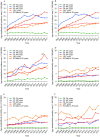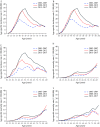Trends in Incidence Rates, Mortality Rates, and Age-Period-Cohort Effects of Cervical Cancer - China, 2003-2017
- PMID: 36751372
- PMCID: PMC9889234
- DOI: 10.46234/ccdcw2022.216
Trends in Incidence Rates, Mortality Rates, and Age-Period-Cohort Effects of Cervical Cancer - China, 2003-2017
Abstract
Introduction: This study reported the trends and analyzed the age-period-cohort effects on the incidence and mortality rates of cervical cancer in China.
Methods: The age-standardized incidence rate (ASIR) and mortality rate (ASMR) by Segi's world standard population were calculated using qualified consecutive data from 22 cancer registries from 2003 to 2017 in China. We performed joinpoint analysis to describe the trends and age-period-cohort analysis to estimate the independent effects of age, period and cohort on trends in incidence and mortality rates of cervical cancer.
Results: The ASIR and ASMR for cervical cancer in females over 20 years old increased during 2003-2017. For females <50 years, a decreasing trend in ASIR and a stable trend in ASMR were observed in urban areas after 2009. But the ASIR and ASMR kept increasing in rural areas during the whole period. For females >50 years, the ASIR and ASMR increased both in urban and rural areas. Age-period-cohort analysis showed increasing period effects on cervical cancer incidence and mortality during the whole period. The cohort effects exhibited a downward-upward-downward pattern for the incidence (1918-1938, 1938-1963, 1963-1993) and mortality rates (1918-1943, 1943-1963, 1963-1993) in urban areas, a fluctuating pattern for incidence rate and a continuing downward pattern for mortality rate (1918-1993) in rural areas.
Conclusions: The increases in cervical cancer incidence and mortality rates can be mostly explained by period effects. We observed decreases in risk for cervical cancer incidence and mortality in young female generations, which were more obvious in urban areas.
Keywords: age-period-cohort incidence; cervical cancer; mortality.
Copyright and License information: Editorial Office of CCDCW, Chinese Center for Disease Control and Prevention 2022.
Conflict of interest statement
No conflicts of interest.
Figures




Similar articles
-
Trends in Incidence Rates, Mortality Rates, and Age-Period-Cohort Effects of Female Breast Cancer - China, 2003-2017.China CDC Wkly. 2023 Apr 14;5(15):340-346. doi: 10.46234/ccdcw2023.065. China CDC Wkly. 2023. PMID: 37193084 Free PMC article.
-
[The spatio-temporal trend of female breast cancer incidence and mortality in Shandong Province from 2012 to 2023 and trend prediction].Zhonghua Liu Xing Bing Xue Za Zhi. 2025 Apr 10;46(4):646-654. doi: 10.3760/cma.j.cn112338-20240830-00539. Zhonghua Liu Xing Bing Xue Za Zhi. 2025. PMID: 40274571 Chinese.
-
[Trends of stomach cancer incidence and mortality in Shandong province from 2012 to 2012 and predictions from 2023 to 2030].Zhonghua Zhong Liu Za Zhi. 2024 Sep 23;46(9):871-877. doi: 10.3760/cma.j.cn112152-20231227-00387. Zhonghua Zhong Liu Za Zhi. 2024. PMID: 39293990 Chinese.
-
Trends of Esophageal Cancer Incidence and Mortality and Its Influencing Factors in China.Risk Manag Healthc Policy. 2021 Nov 30;14:4809-4821. doi: 10.2147/RMHP.S312790. eCollection 2021. Risk Manag Healthc Policy. 2021. PMID: 34876863 Free PMC article.
-
The epidemiology, etiology, and future prophylactic options for cancers in Mainland China.Front Oncol. 2025 May 28;15:1579378. doi: 10.3389/fonc.2025.1579378. eCollection 2025. Front Oncol. 2025. PMID: 40502633 Free PMC article. Review.
Cited by
-
Accelerating Cervical Cancer Prevention and Control in China to Achieve Cervical Cancer Elimination Strategy Objectives.China CDC Wkly. 2022 Dec 2;4(48):1067-1069. doi: 10.46234/ccdcw2022.215. China CDC Wkly. 2022. PMID: 36751370 Free PMC article. No abstract available.
-
Performance of a Full-Coverage Cervical Cancer Screening Program Using on an Artificial Intelligence- and Cloud-Based Diagnostic System: Observational Study of an Ultralarge Population.J Med Internet Res. 2024 Nov 20;26:e51477. doi: 10.2196/51477. J Med Internet Res. 2024. PMID: 39566061 Free PMC article.
-
Cancer incidence and mortality in China, 2022.J Natl Cancer Cent. 2024 Feb 2;4(1):47-53. doi: 10.1016/j.jncc.2024.01.006. eCollection 2024 Mar. J Natl Cancer Cent. 2024. PMID: 39036382 Free PMC article.
-
Cervical cancer incidence, mortality, and burden in China: a time-trend analysis and comparison with England and India based on the global burden of disease study 2019.Front Public Health. 2024 Mar 6;12:1358433. doi: 10.3389/fpubh.2024.1358433. eCollection 2024. Front Public Health. 2024. PMID: 38510348 Free PMC article.
-
Prediction study of prognostic nutrition index on the quality of life of patients with cervical cancer undergoing radiotherapy and chemotherapy.PeerJ. 2023 May 19;11:e15442. doi: 10.7717/peerj.15442. eCollection 2023. PeerJ. 2023. PMID: 37223117 Free PMC article.
References
-
-
Segi M. Cancer mortality for selected sites in 24 countries (1950-1957). Sendai: Department of Public Health. 1960. https://discover.libraryhub.jisc.ac.uk/search?ti=Cancer%20Mortality%20for%20Selected%20Sites%20In%2024%20Countries&rn=3.
-
-
- Yang Y, Schulhofer-Wohl S, Fu WJ, Land KC The intrinsic estimator for age-period-cohort analysis: what it is and how to use it. Am J Sociol. 2008;113(6):1697–736. doi: 10.1086/587154. - DOI
LinkOut - more resources
Full Text Sources
